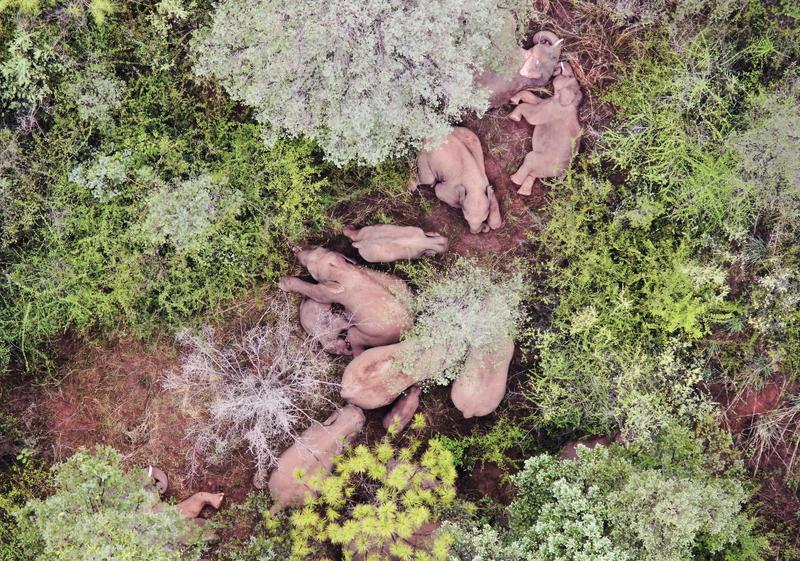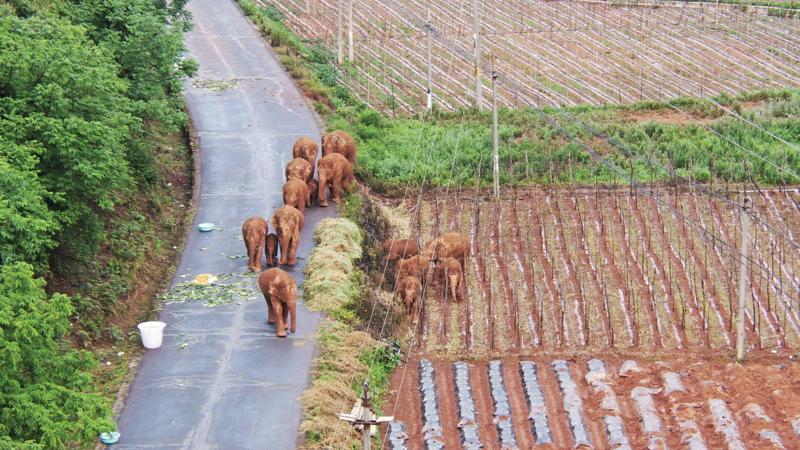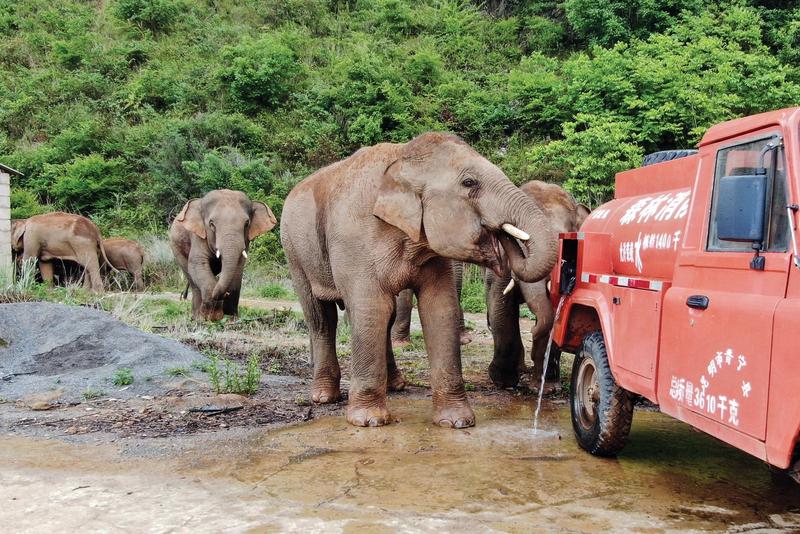Editor’s note: As the world watches in fascination the journey of a herd of wild Asian elephants that has left its habitat, marched north and is wandering in Yunnan province, China Daily looks at their movements and China’s huge conservation efforts.
 Wild Asian elephants take a break in a mountainous area in Yuxi, Yunnan province, on June 11. (PHOTO / YUNNAN FOREST FIRE BRIGADE)
Wild Asian elephants take a break in a mountainous area in Yuxi, Yunnan province, on June 11. (PHOTO / YUNNAN FOREST FIRE BRIGADE)
Wildlife experts have praised China’s use of new technology and sympathetic conservation practices to protect a herd of wild elephants marching through Yunnan province.
China can take a new approach as it comes up with its own model to deal with the elephant group, said Asian elephant expert Raman Sukumar, an honorary professor with the Center for Ecological Sciences at the Indian Institute of Science.
With the resources it has, China can find a way to keep the elephants safe, create a new habitat for them or take them home, Sukumar said.
The herd of 15 wild Asian elephants has trekked 500 kilometers after leaving a designated protection zone in Xishuangbanna National Nature Reserve in Yunnan.
According to experts, the trek is unlikely to have been caused by human activities because their natural habitat is a heavily protected national nature reserve.
After a recent stop on the outskirts of Kunming, 12 of them are now roaming south of the provincial capital near Yuxi, with their every move watched by forestry officials and legions of social media users.
Elephants from the area have a habit of migrating, sometimes into human settlements, Chen Fei, director of the National Forestry and Grassland Administration’s Asian Elephant Research Center, said. In 1995, five Asian elephants marched north to Pu’er city. In 2005, a herd of 13 ventured west into Lancang Lahu autonomous county. Last year, a family of 14 females and three males left Mengyang and traveled south to the Menglun region of the reserve.
“Asian elephants’ roaming area has been expanding in all directions. Long distance migration of wild animals depends on the environmental conditions and the area’s connectivity,” Chen said.
“This time, a herd of 15 Asian elephants can go north all the way to Kunming unimpeded because there is plenty of food from farms and restored forest land along the way. The local government and residents have also escorted the herd and reduced the likelihood of human-elephant conflict.”
 Appetizing crops on a farm by the roadside prove too tempting for some members of the elephant herd as they move through the town of Shuanghe in Jinning district, on the outskirts of Kunming, on June 4. (PHOTO / XINHUA)
Appetizing crops on a farm by the roadside prove too tempting for some members of the elephant herd as they move through the town of Shuanghe in Jinning district, on the outskirts of Kunming, on June 4. (PHOTO / XINHUA)
The current odyssey began late last year when 17 elephants left their natural habitat in the Xishuangbanna Dai autonomous prefecture, in Yunnan’s south.
Of the 17, two elephants gave the group’s travel plans a rethink after stumbling upon some alcohol in a village and returned to the herd’s old habitat. Later, another male also left.
As of June 12 evening, local authorities reported that 14 elephants of the main herd, including three calves, were roaming in Yimen county, Yuxi. The male elephant that left the group about a week ago reached Jinning district of Kunming, the provincial capital, straying about 15 kilometers from the group.
During their extraordinary march, no injuries have been reported among the herd as authorities marshalled extraordinary resources to monitor them and keep them away from residential areas. Forest fire brigade and public security departments at the provincial and township levels have sent teams to track elephants round the clock.
Local residents and officials have provided them with food and water. Drones and distance-imaging have been used to monitor the herd’s movements and hundreds of emergency personnel and vehicles have been mobilized to keep the elephants safe and prevent conflicts with people.
Media coverage of the pachyderms’ progress has aroused interest throughout the world, especially in Asian countries such as India, Thailand and Cambodia, which have strong cultural links to the animals.
Photos and video clips of their march through towns and forests have been widely posted on social media as well as images of the sympathetic approach to the elephants taken by wildlife officials and emergency workers.
“The authorities are doing their best to use technology and to safeguard these elephants to the best of their ability, which is highly commendable,” said Mark Rayan Darmaraj, country director for Malaysia at the Wildlife Conservation Society.
The challenge for authorities is working out what needs to be done next, Darmaraj said. This includes continuing to provide safe passage for the herd, guiding them toward the closest available safe haven and possibly relocating the entire herd back to their Xishuangbanna habitat.
“Each of these comes with its own risk, uncertainty, cost and challenges which need to be evaluated further,” Darmaraj said.
 Support workers operate drones to monitor the movements of the herd on June 5. Heavy storms hit parts of Yunnan around that time. (PHOTO / XINHUA)
Support workers operate drones to monitor the movements of the herd on June 5. Heavy storms hit parts of Yunnan around that time. (PHOTO / XINHUA)
The elephant herd has caused more than US$1 million worth of damage, according to Xinhua News Agency.
The Asian elephant, which is listed on the International Union for Conservation of Nature Red List of Threatened Species as endangered, enjoys Class-A protection in China — the same level as the giant panda.
Yunnan is the sole habitat of wild Asian elephants in China. Due to determined protection efforts in recent decades, their numbers have risen from about 170 in the 1970s to around 300, according to the Yunnan Provincial Forestry and Grassland Administration.
The province has established 11 nature reserves covering about 510,000 hectares. The number of counties with Asian elephants in Yunnan has risen from seven in 2017 to eight. Last year, 7,500 hectares were transformed into new habitat for the animals.
Due to these efforts, Xishuangbanna Dai has seen a significant growth in its population of elephants and other wild animals in recent decades.
In the latest survey of wild animals near the China-Laos border, cameras had captured images of several endangered wild animals including Asian elephants, leopards, jackals, bears and zibets.
In recent years, the prefecture has drafted more than 20 regulations and laws to further protect its environment and wildlife, which has contributed to the growing population of wild animals.
Commercial activities are now prohibited in all of the prefecture’s nature reserves. Rainforests, the region’s typical ecosystem, are also strictly protected and not allowed to be exploited or used as farmland.
The prefecture also made a stand against wild animal trafficking as well as illegal trade in wildlife, and has achieved considerable results. In the past five years, no report of illegal hunting or attacks on elephants was recorded, according to the Xishuangbanna Forestry and Grassland Administration.
Between January and May of this year, the number of cases involving the illegal destruction of forest resources in the prefecture has declined by 76.6 percent compared with the same period last year.
All of the Asian elephants in Yunnan, the main habitat of the animal, live in the southern part of the province, which covers Xishuangbanna, and the cities of Pu’er and Lincang. Of the three, Xishuangbanna has the largest number of Asian elephants.
 Emergency personnel have been brought in to support the monitoring operations, including this driver who shows a photo of the elephants taken during one of these missions on June 4. (LIU RANYANG / CHINA NEWS SERVICE)
Emergency personnel have been brought in to support the monitoring operations, including this driver who shows a photo of the elephants taken during one of these missions on June 4. (LIU RANYANG / CHINA NEWS SERVICE)
In 1996, a Wild Asian Elephant Valley was established, which has served as the prefecture’s biggest wild animal rescue center. So far, more than 1,200 animals have been saved at the center.
In 2008, China’s first Asian elephant breeding base was also built in the valley. With a total investment of more than 7 million yuan (US$1.09 million), the base has provided technical and professional support for the study of elephants.
A significant increase in the population of elephants is a reflection of all these efforts.
Sangduen Chailert, founder of the Save Elephant Foundation in Thailand, said the reason why elephants choose to walk into public places can be complicated.
Intrusions into urban areas have become more prevalent across Asia over the past five years, she added.
“In Thailand, what we found is that sometimes the elephants get lost, the habitat was not safe, or the baby elephant is captured,” Sangduen said, adding that a lack of food and water and pregnancy can all be among the reasons.
“It is not safe for them (the elephants) to be in the town,” she said. “They don’t belong there. They should go back to the wild.”
The attitude and tolerance exhibited by the Chinese people toward the 15 elephants that have been wandering through Yunnan province is not only fascinating, but offers key lessons for Africa, according to Iain Douglas-Hamilton, the founder of Save the Elephants, a Kenyan-based charity working around the world to protect elephants.
He noted that Africa has experienced numerous conflicts between humans and elephants when compared with China. The continent can draw lessons from the positive attitude shown by the Chinese people toward the elephants that have trekked more than 500 kilometers, he said.
Douglas-Hamilton said the Chinese have strictly adhered to authorities’ instructions to treat the wild animals with respect, avoid getting too close to or teasing them, and not hurt them or forcefully drive them away.
The Chinese public has a humane approach despite the herd causing more than US$1 million damage to crops. In contrast, Africa has recorded several cases of communities retaliating for the loss of livestock or crops by trying to kill the offending animals.
Douglas-Hamilton, one of the world’s leading experts on the animals, said China has placed high value on its elephants, and he applauded the country’s concept of ecological civilization that considers nature to be part of life, rather than something that can be exploited without restraint.
While China has managed human-wildlife conflicts remarkably well, Douglas-Hamilton said the increasing number of Chinese tourists visiting Africa’s national parks and game reserves suggests that there are also some lessons that China can learn from the continent.
 A fire engine makes for an impromptu watering hole for the herd as they keep on the move in the town of Shuanghe in Kunming’s Jinning district on June 3. (PHOTO / XINHUA)
A fire engine makes for an impromptu watering hole for the herd as they keep on the move in the town of Shuanghe in Kunming’s Jinning district on June 3. (PHOTO / XINHUA)
China’s ban on the domestic trade of ivory products, introduced at the end of 2017, is laudable and is a reflection of the country’s change of attitude on the protection of African elephants. The elephant situation in Kenya has improved over the past five years, Douglas-Hamilton said, noting that a decade ago Kenya was losing elephants faster than the rate at which the animals could reproduce.
“China’s attitude is largely part of the improvement,” he said, adding that China is also collaborating with many international conservation agencies to try to stop illegal trafficking of ivory.
Sukumar, from the Indian Institute of Science, said long-term strategies are needed in China to resolve habitat problems as “you cannot allow the elephants to go on the streets”.
Apart from returning the herd to its home, China could create a second habitat for the elephants, he said.
“The exact reason is still unclear,” The Straits Times quoted Professor Sun Quanhui of World Animal Protection as saying, in response to the question of what could be prompting the Yunnan elephants to wander into new areas.
“But it could be that, along with conservation efforts, the population of Asian elephants in the wild has grown and in a bid to find more territory and resources, elephants could be leaving (nature reserves),” he said.
According to Dong Yonghua, who has studied Asian elephants for 40 years at the Scientific Research Institute of Xishuangbanna National Nature Reserve, the growing elephant population means there is larger requirement for living space for the species.
“About 25 years ago, elephants could be witnessed only in Xishuangbanna and Lincang. Now, Pu’er has also become one of their habitats,” he said.
Xishuangbanna Dai prefecture invested 2.8 million yuan in an elephant monitoring and alert system in 2018. So far, the system has more than 200,000 registered users.
In Xishuangbanna’s Menghai county, where residential areas are close to the nature reserves, a project was initiated last year in the village of Nanlanghe.
This project includes the construction of iron barriers as long as 2,363 meters and also the planting of food resources preferred by elephants, such as corn, sugar cane, Chinese banana and grass, within a certain area near the village.
“So far, four elephants that used to visit local villages have been attracted to the area in the first half of this year,” said Ma Jie, head of Menghai county forestry and grassland administration.
Thanks to the project, he said that insurance payouts for property losses due to elephants’ activities dropped sharply from 2 million yuan in the first half of last year to 30,000 yuan in the same period of this year.
Moreover, the prefecture has constructed several areas to provide additional food resources for elephants in recent years.
“A harmonious relationship between humans and elephants has been our goal, for which we will continue our efforts without hesitation,” said Dao Jianhong, deputy director of Xishuangbanna Forestry and Grassland Administration.
Li Yingqing, Zhang Zhihao and Edith Mutethya contributed to this story.
Contact the writers at kelly@chinadaily.com.cn


